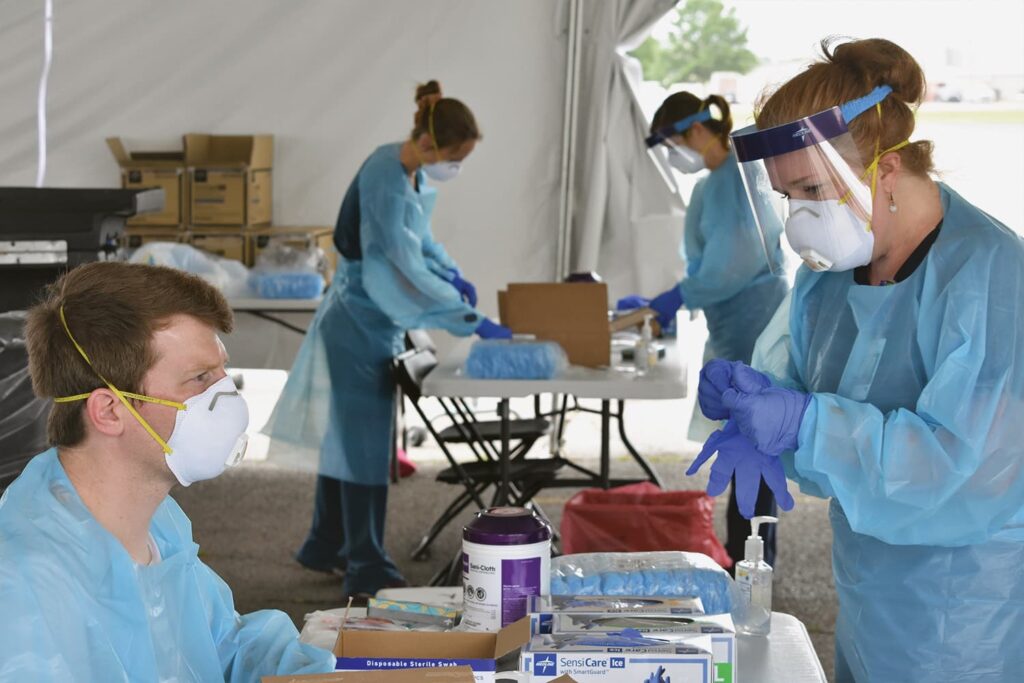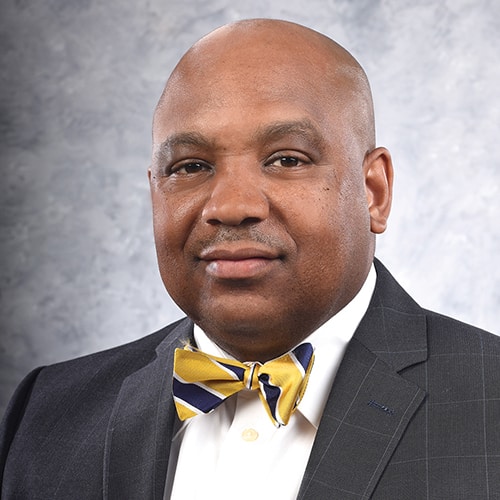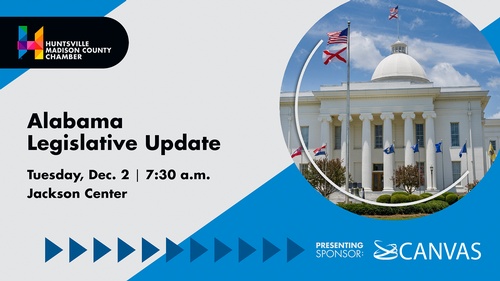[divider height=”20″]
Local hospitals experience strain with patient load, testing
By Claire Aiello, Vice President, Marketing & Communications
The playbook for 2020 went out the window several months ago. We are in the midst of a pandemic that is affecting all areas of our lives. Many of us have dealt with illness, and some have lost loved ones to COVID-19. Others have lost income to support their families. Yet, we have seen many examples of helpers and leaders. How the Huntsville/Madison County community continues to respond is what will define us when we look back on this time in our lives.
We’ve written this piece as a snapshot in time.

When this issue of Initiatives went to print in mid-July, the Alabama Department of Public Health had Madison County as “very high risk,” and testing was also high. Huntsville Hospital and Thrive Alabama teamed up for drive-through testing at John Hunt Park (shown above), and testing also continued at the Huntsville Hospital Fever & Flu Clinic on Governors Drive. During the second week of the month, 3,500 people showed up for testing, and the Huntsville Police Department supported the effort by managing traffic flow. Health leaders say the rate of people testing positive at those two locations had grown to more than 11 percent, pointing to 11 percent of the community having the virus but not getting tested. The hospitalization rate was 15.6 percent for the same time period.

Our hospitals were also becoming strained. Even though we avoided a spike months earlier, plans to care for a much larger load of patients had to be put into play. Many people bypassed testing and went straight to the ER for treatment, according to Tracy Doughty, senior vice president of Operations for Huntsville Hospital. The hospital also added ICU units and converted four nursing floors in the Madison Street Tower to COVID rooms, all with air flow adjusted to negative pressure.
“That way, potentially contaminated air is appropriately filtered and does not get released into the hallway,” Doughty explained.
Staffing also became a serious concern, and there were two reasons for this. First, some employees caught the virus through community spread and needed to quarantine. “Additionally, the more COVID patients we have, it changes the amount of staff needed to take care of those patients. That creates an increased number of clinicians who we need,” said Doughty.
Outpatient surgeries continued, but anything requiring an overnight stay was delayed, so the hospital could re-route those team members to COVID care. Stress was definitely a factor, but the hospital had several support programs.
“We’ve got a good group of staff members, and have several things in place to help them, from prayers, ways to take care of themselves, a counseling hot line and support groups they can attend, if they want to talk with someone about what they are going through,” said Doughty.
Testing: “A Herculean Effort”
Back to testing. Getting through it is one thing – the nasal swab can be quite painful – but you also need the results. That’s where companies like Diatherix come into play. Diatherix is located on the campus of HudsonAlpha Institute for Biotechnology and is part of Eurofins, an international biological testing company. Dr. Jeff Wisotzkey is the chief science officer and laboratory director, and says he’s incredibly proud of his team.
“They are made of iron. They’re all incredible,” Wisotzkey said. “They come in every day, they start early, they work long hours and come back the next day to handle the high test volume. It is a Herculean effort.”
How many tests in a day? A normal day used to involve 1,500 to 2,000 tests, Wisotzkey explained. The load is much higher now. “Now, we’re having days where we’re processing over 10,000 tests a day. It really pushes our limit, and all labs are seeing that,” he said.
Diatherix has about 170 people working at the Huntsville facility (shown below). The team has grown recently, with more than 60 employees coming on in recent months. Several dozen process samples in the lab, and many others work in client services, communicating with doctors’ offices to take in tests and relay results.
“We’ve been hiring and training a lot lately,” Wisotzkey said. “It takes six months to train a molecular technologist to do everything we do, but we can train someone on a few things so they can be useful right away, and that’s what we’ve been doing to keep up with demand.”
Diatherix runs tests for people in the Huntsville area, but also tests for more than 30 other states. Even if our local situation improves, Wisotzkey admits the long days will likely continue for a while.
“Even our best-laid ramp up capacity planning is being outpaced by the demand in testing, much like other laboratories, and we really need the community to do their part to social distance, to wear their mask, to wash their hands, to really do their part to help quell this pandemic,” he said. “The lab can’t do it. The physicians can’t do it. It has to be a population/community-based effort.”
Mask Up Huntsville
 As the virus started to take hold in our community, health leaders pushed more strongly on the message they have shared since the beginning: the need for masking and social distancing. “If 80 percent of our community would mask, cover their faces, then we would reduce transmission by 90 percent,” Dr. Pam Hudson, CEO of Crestwood Medical Center, said at a community briefing. “If we’re not performing at that level, we’re going to continue to see this.”
As the virus started to take hold in our community, health leaders pushed more strongly on the message they have shared since the beginning: the need for masking and social distancing. “If 80 percent of our community would mask, cover their faces, then we would reduce transmission by 90 percent,” Dr. Pam Hudson, CEO of Crestwood Medical Center, said at a community briefing. “If we’re not performing at that level, we’re going to continue to see this.”
The Huntsville/Madison County Chamber urged citizens and businesses to “Mask Up Huntsville” – releasing messaging on July 2. You may have seen the image on billboards and storefronts, as well as social media – thank you for spreading the word! There were indications a mandate would soon follow, and the Madison County Board of Health indeed passed an ordinance that took effect July 7.
Wearing a mask isn’t fun, especially in the Alabama summer heat, but it’s what we as citizens can do to protect each other.
“I’d like to suggest we think about this masking and distancing as a temporary vaccination,” said Dr. Pam Hudson. “We are waiting for the scientists and the pharmaceutical companies to come up with a vaccine that works. It’s months away. Meanwhile, we have to save ourselves for the day that we will have access to the vaccine.”
Other health leaders echoed the need for citizens to embrace preventive steps to stop the virus from spreading further, including Dr. Aruna Arora, vice president of the Madison County Medical Society and president-elect of the Medical Association of the State of Alabama.
“We continue to believe that we should take care of ourselves as a responsible community,” said Dr. Arora. “We want the economy open, we want the businesses open, and we want school open. We feel the best way forward to do this is to wash hands, socially distance, and wear a mask/ face covering over the mouth and nose to significantly lower the spread of droplets which contain the virus.”
Here for a while
We’ll likely be wearing masks for a while. It could be months, but some speculate it could be much longer. Schools will require everyone to wear them as classes resume. Plan ahead now and stock up, so you have a good supply for your family. We’ve posted resources on how to make masks, as well as information for local member companies that are selling these.
This article appears in the August 2020 issue of Initiatives magazine, a publication of the Huntsville/Madison County Chamber.




